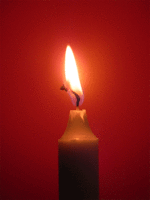Pyromancy
This article needs additional citations for verification. (May 2011) |

Pyromancy (Ancient Greek ἐμπυρία (empyria), divination by fire)[1] is the art of divination by means of fire or flames.[2]
The word pyromancy is adapted from the Greek word pyromanteia, from pyr (πῦρ, fire)[1] and manteia (μαντεία, divination by means of).[1] Its first known use was in the 1300s, and it evolved into the Late Latin word piromantia and Old French word piromance.[2]
History of pyromancy
Due to the importance of fire in society in prehistory and its continued importance within civilizations, it is quite likely that pyromancy was one of the earlier forms of divination, arising independently in many civilizations around the world.
In much of Western culture, fire was often associated with a god, or was revered as a god itself. Fire was associated with a living being (because it ate, breathed, grew, decayed, and died) in both Western and non-Western religions. Fire was so basic to the human experience that it persisted in the minds of humanity as an element close to nature.[3]
Fire rituals in
In the
In Renaissance magic, pyromancy was classified as one of the seven "forbidden arts", along with necromancy, geomancy, aeromancy, hydromancy, chiromancy (palmistry), and scapulimancy.[5]
Fire
Types of pyromancy
The most basic form of pyromancy is that in which the diviner observes flames, from a sacrificial fire, a candle, or another source of flame, and interprets the shapes that he or she sees within them. However, there are several variations of pyromancy, some of which are as follows:
- Alomancy: divination by salt, one type of which involves casting salt into a fire
- Botanomancy: divination by burning plants
- Capnomancy: divination by smoke; light, thin smoke that rose straight up was a good omen; otherwise, a bad one.
- Causinomancy: divination by burning (non-specific as to the object burned)
- Daphnomancy (also called empyromancy): divination by burning laurel leaves
- Osteomancy: divination using bones, one type of which involves heating to produce cracks
- plastrons; in China, this was done by heating pits carved into them.
- Scapulimancy: divination by scapulae; in Asia and North America, this was done through pyromancy.
- Sideromancy: divination by burning straw with an iron.
See also
| Part of a series on |
| Artes Prohibitae |
|---|
|
References
- ^ a b c Liddell, H.G. & Scott, R. (1940). A Greek-English Lexicon. revised and augmented throughout by Sir Henry Stuart Jones. with the assistance of. Roderick McKenzie. Oxford: Clarendon Press.
- ^ a b “Pyromancy.” Merriam-Webster.com Dictionary, Merriam-Webster, https://www.merriam-webster.com/dictionary/pyromancy . Accessed 26 Jan. 2023.
- ^ PMID 27216523.
- .
- ^ a b Johannes Hartlieb (Munich, 1456) The Book of All Forbidden Arts; quoted in Láng, p. 124.
- ^ Kory, Stephen (2015). "From Deer Bones to Turtle Shells". Japanese Journal of Religious Studies. 42: 339–380.
- JSTOR 3772966.
